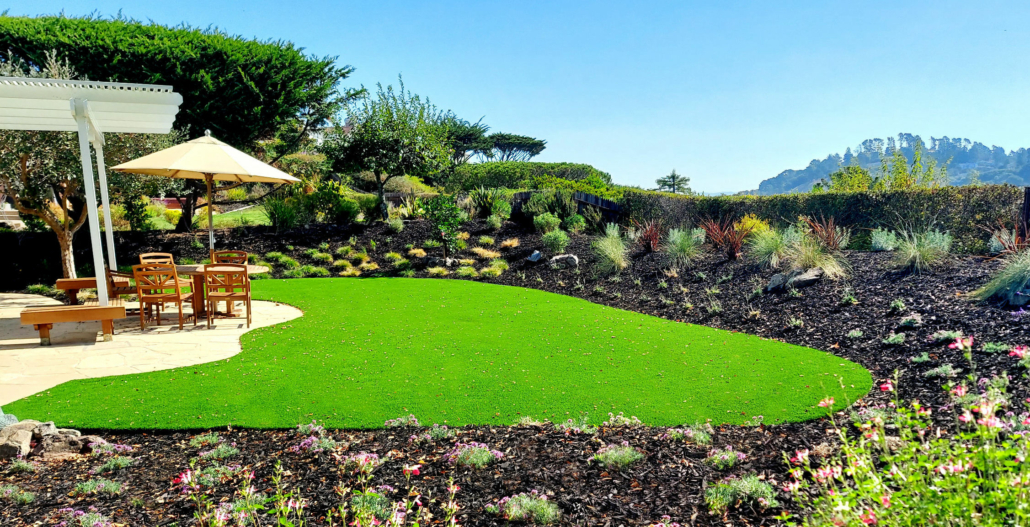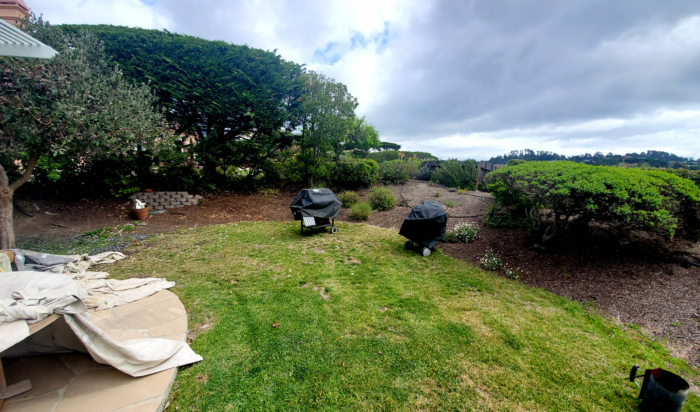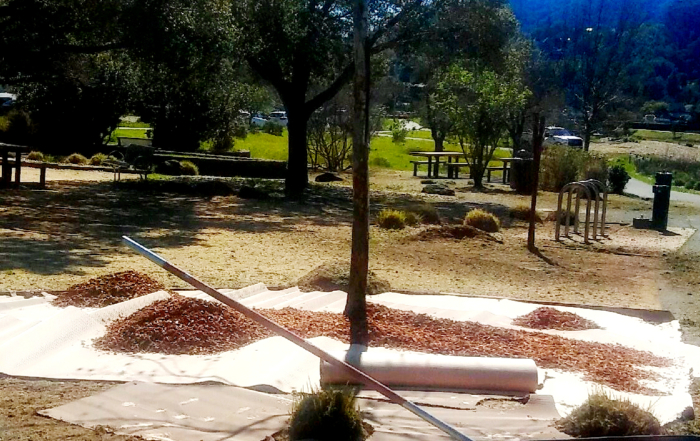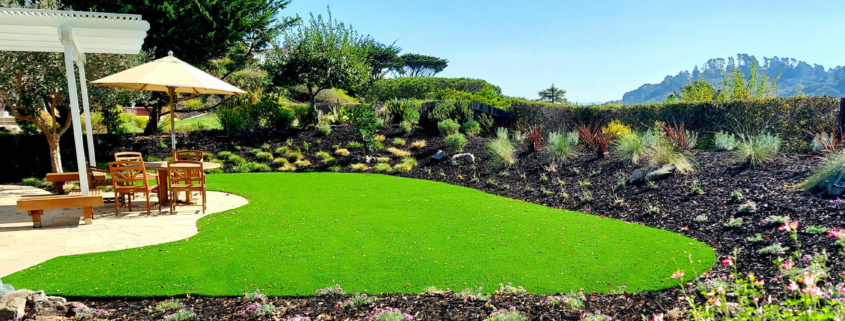10 Things You Need To Know About Removing Your Lawn

AFTER — Turf conversion project in Tiburon
3 Reasons to get rid of your lawn
Many of us may feel that despite doing our part to conserve water, we’re being penalized for having turfgrass. That said, we’re in a crisis. For good reasons, the State of California has put our beloved lawns on the chopping block.
This month we take you step-by-step with expert advice on removing your lawn. Why do it, how, and what to replace it with, including artificial turf. See the photo above. This beautiful landscape — once grass — is now a combination of artificial turf and drought-tolerant plants on the perimeter slope. One way. See the before image below.
By the way, now is the best time to plan to get rid of your lawn. Especially if you want to replace it with plants, this is because autumn is cooler, plants need less water, and there is the potential for at least some rain. Crossing fingers.
Here are the reasons to get rid of your lawn
- It uses more water than any other plant. 40-60 percent of the state’s landscape water. Says the University of California, Division of Agriculture and Natural Resources.
- Turf grass is prone to compaction. This is when the soil hardens and eventually can’t absorb water. Studies show that nitrogen, an ingredient in fertilizer, contributes to compaction.
- Lawns need a lot of maintenance. Besides water, they require mowing, edging, and fertilization. Plus, aeration, is necessary to prevent compaction.
3 Easy, drought tolerant alternatives
1. Grass alternatives
Marin Master Gardeners recommended them. They require only a tiny fraction of the water used by conventional turfgrass.
Below is a partial list of options. Before considering these options, make sure they fit your area’s microclimate.
- White Clover — does not show pet urine damage.
- UC Verde Buffalo Grass
- Catlin Sedge — only needs mowing once a year.
- Dymondia — super durable
- Kurapia — they have long roots. Perfect for hillsides.
- Thyme — it has a lovely scent!
2. Artificial turf — everything you need to know
Read this before saying no to artificial turf. It’s come a long way since the days it was called astroturf. It helped transform the property featured above — see the before photo below. Talk to Gardeners’ Guild if you are considering artificial turf. We can advise and give you an informed assessment of what works for you.
We’ve compiled all the benefits.
- Zero water and no fiddling with irrigation programming etc.
- It will always be green.
- Low maintenance. No mowing, edging, weed control, or irrigation.
- No noise because no gas-powered equipment is required for maintenance — good for the environment.
The most updated facts
- An increasing number of artificial turf products are made of natural, renewable, or recyclable materials.
- The grass will heat up a bit on hotter days, unlike asphalt, brick walls, or concrete.
- It is safe for your pets or children, even on hot days.
- Many artificial turf providers will offer to recycle/reuse it when it gets old.

BEFORE — Turf conversion project
3. Drought tolerant plants
Some of the most beautiful landscapes in the bay area are a combination of drought-tolerant natives, perennials, mulch, and hardscape options such as walking paths with gravel, decomposed granite, or pavers. There is an endless assortment of options that will fit most budgets. As with grass alternatives — pick plants that are best for your environment.
Most San Francisco Bay Area water agencies have a list of recommended plants.
The image below is a sampling of popular drought-tolerant plants. Each has multiple varieties.

Below are links to several districts’ web pages with recommendations.
- East Bay Municipal Water District
- Contra Costa Water Agency
- North Marin Water District
- Marin Municipal Water District
- Santa Rosa Water Agency – they have a great list compiled by Sonoma Marin Partnership
- Solano County Water Agency – They use the UC Davis database as a resource.
- City of Cotati
4 Ways to remove your lawn
Removing your lawn can be a time-consuming process, but fortunately, there are a lot of tools.

Sheet mulching project
1. Sheet mulching
This method is fast. It kills grass by starving it of light. Dead plant material breaks down and will enrich the soil.
The benefits: you can plant immediately after sheet mulching, and by reusing newspaper or cardboard, you’ll enrich the soil.
How to do it.
First, cut the grass as short as possible.
Next, cover the entire area with cardboard, purchased rolls as shown above, or newspaper.
Most importantly, ensure that edges overlap so that no sunlight can get through the grass.
Next, water the paper, then cover it with a layer of compost and mulch.
2. Physical removal
Another quick method. But it’s the most labor-intensive and potentially costly method. Before taking on this option, check with your local refuse company about where to dispose of it. Sod is easier to remove. Master Gardeners suggest cutting it into strips with a sod cutter or flat shovel and rolling it up.
3. Solarization
This is the cheapest, takes the least amount of labor but is the slowest method. However, if you consider it’s killing the turf by sterilizing it, solarization is the most interesting. The wonder of science.
How to do it.
Cover the entire area with black plastic. This method is reliant on the heat of summer to do its job of killing the grass.
Master Gardeners say it takes four to eight weeks. The timing depends on how hot it is.
4. Herbicides
It’s everyone’s least favorite option. But it is an option. There are multiple products, including Roundup. Most important is to read the instructions. Ideally, have this performed by a professional.
Save money with rebates.
Most of the bay area water agencies are still offering rebates.
The report below includes each agency offering rebates, the amount, and the types of rebates.
Each water district has a set of requirements. We can help you. Gardeners’ Guild has much experience navigating the process.
Closing Thoughts
If you still want to have a small turfgrass area, consider a partial lawn conversion. The results can give a landscape attractive colors and textures. You might also decide to approach your lawn removal in phases. Especially if you have budget constraints. Consult with a certified professional with experience, and knowledge.
We don’t know how long this drought will persevere. Because it’s impacting everyone, it’s safe to assume that the State of California is getting pressure to take bolder actions to safeguard our water supply.
The website CalMatters.org reported in August on the Governor’s long-term strategy. The plan will bolster the state’s water supply by recycling more water and expanding reservoirs’ storage capacities. This includes groundwater. The program also touches on the desalination of brackish (a mixture of sea and river) water. Stay tuned. I’ve subscribed to Cal Matters’ newsletter and will pass along any relevant updates.




How great that you talk about how to do mulching on your own. I am building my own home this year and want a great yard as well. I will find a good buffalo turf service locally to help with my yard.